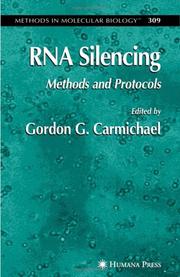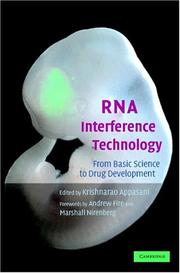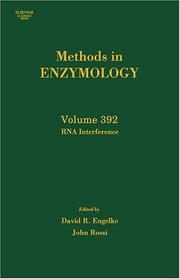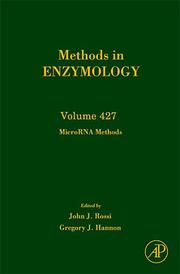| Listing 1 - 10 of 46 | << page >> |
Sort by
|
Book
ISBN: 0128013354 012801122X Year: 2014 Publisher: Waltham, Massachusetts : Academic Press,
Abstract | Keywords | Export | Availability | Bookmark
 Loading...
Loading...Choose an application
- Reference Manager
- EndNote
- RefWorks (Direct export to RefWorks)
This new volume of Methods in Enzymology continues the legacy of this premier serial with quality chapters authored by leaders in the field. This volume covers research methods in riboswitch discovery and validation, synthesis and sample prep methods for large RNAs, riboswitch structure and function methods, folding pathways and dynamics, and ligand interactions and thermodynamics.Continues the legacy of this premier serial with quality chapters authored by leaders in the fieldCovers research methods in biomineralization scienceContains sections on such topics as riboswitch discovery and valid
Small interfering RNA. --- piRNA (Piwi-interacting RNA) --- Piwi-interacting RNA --- Piwi protein-interacting RNA --- rasiRNA (Repeat-associated small interfering RNA) --- Repeat-associated siRNA --- Repeat-associated small interfering RNA --- Scan RNA --- scnRNA (Small scan RNA) --- Short hairpin RNA --- Short interfering RNA --- shRNA (Short hairpin RNA) --- siRNA (Small interfering RNA) --- Small hairpin RNA --- Small scan RNA --- tasiRNA (Trans-acting small interfering RNA) --- Trans-acting siRNA --- Trans-acting small interfering RNA --- Antisense RNA
Book
ISBN: 0128005548 012800553X 9780128005545 9780128005538 Year: 2017 Publisher: Boston, MA : Elsevier,
Abstract | Keywords | Export | Availability | Bookmark
 Loading...
Loading...Choose an application
- Reference Manager
- EndNote
- RefWorks (Direct export to RefWorks)
Small interfering RNA. --- piRNA (Piwi-interacting RNA) --- Piwi-interacting RNA --- Piwi protein-interacting RNA --- rasiRNA (Repeat-associated small interfering RNA) --- Repeat-associated siRNA --- Repeat-associated small interfering RNA --- Scan RNA --- scnRNA (Small scan RNA) --- Short hairpin RNA --- Short interfering RNA --- shRNA (Short hairpin RNA) --- siRNA (Small interfering RNA) --- Small hairpin RNA --- Small scan RNA --- tasiRNA (Trans-acting small interfering RNA) --- Trans-acting siRNA --- Trans-acting small interfering RNA --- Antisense RNA
Book
ISBN: 1621001520 9781621001522 9781611228465 1611228468 Year: 2011 Publisher: New York Nova Science
Abstract | Keywords | Export | Availability | Bookmark
 Loading...
Loading...Choose an application
- Reference Manager
- EndNote
- RefWorks (Direct export to RefWorks)
Small interfering RNA. --- piRNA (Piwi-interacting RNA) --- Piwi-interacting RNA --- Piwi protein-interacting RNA --- rasiRNA (Repeat-associated small interfering RNA) --- Repeat-associated siRNA --- Repeat-associated small interfering RNA --- Scan RNA --- scnRNA (Small scan RNA) --- Short hairpin RNA --- Short interfering RNA --- shRNA (Short hairpin RNA) --- siRNA (Small interfering RNA) --- Small hairpin RNA --- Small scan RNA --- tasiRNA (Trans-acting small interfering RNA) --- Trans-acting siRNA --- Trans-acting small interfering RNA --- Antisense RNA

ISBN: 1588294366 9786610358991 1280358998 1592599354 Year: 2005 Publisher: Totowa, NJ : Humana Press : Imprint: Humana,
Abstract | Keywords | Export | Availability | Bookmark
 Loading...
Loading...Choose an application
- Reference Manager
- EndNote
- RefWorks (Direct export to RefWorks)
The past decade has witnessed a true revolution in our understanding of how RNA molecules can reduce or silence gene expression, a process that holds great promise in basic research and for antiviral and anticancer applications. In RNA Silencing: Methods and Protocols, many of the most notable and distinguished researchers in the field describe in step-by-step detail their best methods for the design, preparation, and use of RNAs to reduce gene expression in cells and organisms. The techniques range widely and include methods addressing the biochemical aspects of the silencing machinery, RNA silencing in non-mammalian organisms, and the in vivo delivery of siRNAs and silencing vectors. There are also techniques for designing, preparing, and using RNAs to silence gene expression, for fine-tuning regulation by targeting specific isoforms of a given gene, and for the study and use of microRNAs. The protocols follow the successful Methods in Molecular Biology™ series format, each offering step-by-step laboratory instructions, an introduction outlining the principle behind the technique, lists of the necessary equipment and reagents, and tips on troubleshooting and avoiding known pitfalls. Comprehensive and state-of-the-art, RNA Silencing: Methods and Protocols offers today's laboratory investigators a host of optimized and validated techniques to study RNA silencing and translate its concepts into successful practical applications.
Gene expression regulation --- Gene silencing --- Micrornas --- Rna interference. --- Rna, small interfering --- Small interfering rna --- Genetics. --- Physiology. --- Small interfering RNA --- Gene inactivation --- Inactivation, Gene --- Silencing, Gene --- piRNA (Piwi-interacting RNA) --- Piwi-interacting RNA --- Piwi protein-interacting RNA --- rasiRNA (Repeat-associated small interfering RNA) --- Repeat-associated siRNA --- Repeat-associated small interfering RNA --- Scan RNA --- scnRNA (Small scan RNA) --- Short hairpin RNA --- Short interfering RNA --- shRNA (Short hairpin RNA) --- siRNA (Small interfering RNA) --- Small hairpin RNA --- Small scan RNA --- tasiRNA (Trans-acting small interfering RNA) --- Trans-acting siRNA --- Trans-acting small interfering RNA --- Genetic regulation --- Antisense RNA --- Cytology. --- Cell Biology. --- Cell biology --- Cellular biology --- Biology --- Cells --- Cytologists

ISBN: 9780511546402 9780521836777 9780521205177 0511082215 9780511082214 0511546408 9780511081767 0511081766 1280163178 9781280163173 0521836778 1107139740 9786610163175 0511196857 0511121741 0511298315 Year: 2005 Publisher: Cambridge, UK New York Cambridge University Press
Abstract | Keywords | Export | Availability | Bookmark
 Loading...
Loading...Choose an application
- Reference Manager
- EndNote
- RefWorks (Direct export to RefWorks)
RNA Interference (RNAi) technology has rapidly become one of the key methods used in functional genomics. RNAi is used to block the expression of genes and create phenotypes that can potentially yield clues about the function of these genes. In the postgenomic era, the elucidation of the physiological function of genes has become the rate-limiting step in the quest to develop 'gene-based drugs' and RNAi could potentially play a pivotal role in the validation of such novel drugs. In this 2005 overview, the basic concepts and applications of RNAi biology are discussed. Leading experts from both academia and industry have contributed to this invaluable reference. The volume is forwarded by Andrew Fire, one of the winners of the 2006 Nobel Prize for the discovery of RNA Interference.
Small interfering RNA. --- Gene silencing. --- Gene inactivation --- Inactivation, Gene --- Silencing, Gene --- Genetic regulation --- piRNA (Piwi-interacting RNA) --- Piwi-interacting RNA --- Piwi protein-interacting RNA --- rasiRNA (Repeat-associated small interfering RNA) --- Repeat-associated siRNA --- Repeat-associated small interfering RNA --- Scan RNA --- scnRNA (Small scan RNA) --- Short hairpin RNA --- Short interfering RNA --- shRNA (Short hairpin RNA) --- siRNA (Small interfering RNA) --- Small hairpin RNA --- Small scan RNA --- tasiRNA (Trans-acting small interfering RNA) --- Trans-acting siRNA --- Trans-acting small interfering RNA --- Antisense RNA --- Moleculaire biologie --- RNA-interferentie
Book
ISBN: 1603270043 9781603270045 1603270051 Year: 2010 Publisher: Totowa, NJ : Humana Press : Imprint: Humana,
Abstract | Keywords | Export | Availability | Bookmark
 Loading...
Loading...Choose an application
- Reference Manager
- EndNote
- RefWorks (Direct export to RefWorks)
MicroRNAs constitute a particularly important class of small RNAs given their abundance, broad phylogenetic conservation and strong regulatory effects, with plant miRNAs uniquely divulging their ancient evolutionary origins and their strong post-transcriptional regulatory effects. In Plant MicroRNAs: Methods and Protocols, experts in the field present chapters that focus on the identification, validation, and characterization of the miRNA class of RNAs, and address important aspects about heterochromatic small interfering RNAs. In addition, the methods contained in this volume emphasize miRNA analyses, but also include ways to distinguish one class of small RNAs from another. As a volume in the highly successful Methods in Molecular Biology™ series, chapters include brief introductions to their respective topics, lists of the necessary materials and reagents, step-by-step, readily reproducible laboratory protocols, and notes on troubleshooting and avoiding known pitfalls. Authoritative and easy to use, Plant MicroRNAs: Methods and Protocols provides the research community with a set of protocols that will help advance vital miRNA research for all plant species, both in typical model species and non-model species alike.
Micrornas --- Molecular biology --- Plant molecular genetics --- Plants --- Rna, small interfering --- Small interfering rna. --- Methods --- Research --- Methodology. --- Genetics --- Small interfering RNA --- Petits ARN interférents --- RNA, Small Interfering --- MicroRNAs --- RNA, Antisense --- RNA, Small Untranslated --- Antisense Elements (Genetics) --- RNA, Untranslated --- Petits ARN interférents --- Noncoding RNA --- RNA, Non-Coding --- RNA, Non-Peptide-Coding --- RNA, Non-Protein-Coding --- RNA, Noncoding --- RNA, Nontranslated --- npcRNA --- Non-Coding RNA --- Non-Peptide-Coding RNA --- Non-Protein-Coding RNA --- Nontranslated RNA --- RNA, Non Coding --- RNA, Non Peptide Coding --- RNA, Non Protein Coding --- Untranslated RNA --- Anti-Sense Elements --- Anti-Sense Probes --- Antisense Probes --- Anti Sense Elements --- Anti Sense Probes --- Elements, Anti-Sense --- Probes, Anti-Sense --- Probes, Antisense --- Short Noncoding RNA --- Small Non-Coding RNA --- Small Non-Messenger RNA --- Small Non-Protein-Coding RNA --- Small Noncoding RNA --- Small Untranslated RNA --- sncRNA --- sncRNAs --- Non-Coding RNA, Small --- Non-Messenger RNA, Small --- Non-Protein-Coding RNA, Small --- Noncoding RNA, Short --- Noncoding RNA, Small --- RNA, Short Noncoding --- RNA, Small Non-Coding --- RNA, Small Non-Messenger --- RNA, Small Non-Protein-Coding --- RNA, Small Noncoding --- Small Non Coding RNA --- Small Non Messenger RNA --- Small Non Protein Coding RNA --- Untranslated RNA, Small --- Anti-Sense RNA --- Antisense RNA --- Anti Sense RNA --- RNA, Anti-Sense --- Plant --- Micro RNA --- MicroRNA --- Primary MicroRNA --- Primary miRNA --- miRNAs --- pre-miRNA --- pri-miRNA --- RNA, Small Temporal --- Small Temporal RNA --- miRNA --- stRNA --- MicroRNA, Primary --- RNA, Micro --- Temporal RNA, Small --- miRNA, Primary --- pre miRNA --- pri miRNA --- Methodological Studies --- Methodological Study --- Studies, Methodological --- Study, Methodological --- Method --- Short Hairpin RNA --- Short Interfering RNA --- Small Hairpin RNA --- Small Interfering RNA --- piRNA --- scnRNA --- shRNA --- tasiRNA --- Piwi-Interacting RNA --- RNA, Piwi-Interacting --- RNA, Scan --- Repeat-Associated siRNA --- Scan RNA --- Small Scan RNA --- Trans-Acting siRNA --- siRNA --- siRNA, Repeat-Associated --- siRNA, Trans-Acting --- Hairpin RNA, Short --- Hairpin RNA, Small --- Interfering RNA, Short --- Interfering RNA, Small --- Piwi Interacting RNA --- RNA, Piwi Interacting --- RNA, Short Hairpin --- RNA, Short Interfering --- RNA, Small Hairpin --- RNA, Small Scan --- Repeat Associated siRNA --- Scan RNA, Small --- Trans Acting siRNA --- siRNA, Repeat Associated --- siRNA, Trans Acting --- piRNA (Piwi-interacting RNA) --- Piwi-interacting RNA --- Piwi protein-interacting RNA --- rasiRNA (Repeat-associated small interfering RNA) --- Repeat-associated siRNA --- Repeat-associated small interfering RNA --- scnRNA (Small scan RNA) --- Short hairpin RNA --- Short interfering RNA --- shRNA (Short hairpin RNA) --- siRNA (Small interfering RNA) --- Small hairpin RNA --- Small scan RNA --- tasiRNA (Trans-acting small interfering RNA) --- Trans-acting siRNA --- Trans-acting small interfering RNA --- Methodology --- Biochemistry. --- Botany. --- Plant genetics. --- Medical genetics. --- Biochemistry, general. --- Plant Sciences. --- Plant Genetics and Genomics. --- Gene Function. --- Botanical science --- Phytobiology --- Phytography --- Phytology --- Plant biology --- Plant science --- Biology --- Natural history --- Biological chemistry --- Chemical composition of organisms --- Organisms --- Physiological chemistry --- Chemistry --- Medical sciences --- Clinical genetics --- Diseases --- Heredity of disease --- Human genetics --- Pathology --- Genetic disorders --- Composition --- Genetic aspects --- Floristic botany
Book
ISBN: 1281773832 9786611773830 1402085338 140208532X 9048179033 Year: 2008 Publisher: [New York ; Dordrecht] : Springer,
Abstract | Keywords | Export | Availability | Bookmark
 Loading...
Loading...Choose an application
- Reference Manager
- EndNote
- RefWorks (Direct export to RefWorks)
Nearly 97% of the human genome is the non-coding DNA, which varies from one species to another, and changes in these sequences are frequently noticed to manifest clinical and circumstantial malfunction. Numerous non-protein-coding genes are recently found to encode microRNAs, which are responsible for RNA-mediated gene silencing through RNA interference (RNAi)-like pathways. MicroRNAs (miRNAs), small single-stranded 17–25 nucleotide RNAs capable of interfering with intracellular messenger RNAs (mRNAs) that contain either complete or partial complementarity, are useful for the design of new therapies against cancer polymorphism and viral mutation. Currently over 1000 native miRNA species found in vertebrates and many more new miRNA homologs continue to be identified; however, most of their functions remain to be determined. In this book, many new perspectives of the miRNA research are reviewed and discussed, including their roles in stem cell maintenance, embryonic development, tissue differentiation, adult physiology, disease pathology, cancer research, viral infection, genetic engineering in plants, and utility in cosmetic applications. These new findings may not only provide significant insight into the various mechanisms of miRNAs but also offer a great opportunity in developing new therapeutic interventions.
Gene silencing. --- Small interfering RNA. --- piRNA (Piwi-interacting RNA) --- Piwi-interacting RNA --- Piwi protein-interacting RNA --- rasiRNA (Repeat-associated small interfering RNA) --- Repeat-associated siRNA --- Repeat-associated small interfering RNA --- Scan RNA --- scnRNA (Small scan RNA) --- Short hairpin RNA --- Short interfering RNA --- shRNA (Short hairpin RNA) --- siRNA (Small interfering RNA) --- Small hairpin RNA --- Small scan RNA --- tasiRNA (Trans-acting small interfering RNA) --- Trans-acting siRNA --- Trans-acting small interfering RNA --- Antisense RNA --- Gene inactivation --- Inactivation, Gene --- Silencing, Gene --- Genetic regulation --- Human genetics. --- Biomedical engineering. --- Medicine. --- Neurosciences. --- Biotechnology. --- Human Genetics. --- Biomedical Engineering and Bioengineering. --- Biomedicine general. --- Molecular Medicine. --- Chemical engineering --- Genetic engineering --- Clinical sciences --- Medical profession --- Human biology --- Life sciences --- Medical sciences --- Pathology --- Physicians --- Clinical engineering --- Medical engineering --- Bioengineering --- Biophysics --- Engineering --- Medicine --- Neural sciences --- Neurological sciences --- Neuroscience --- Nervous system --- Genetics --- Heredity, Human --- Physical anthropology --- Health Workforce --- Molecular biology. --- Biomedicine, general. --- Molecular biochemistry --- Molecular biophysics --- Biochemistry --- Biomolecules --- Systems biology

ISSN: 00766879 ISBN: 0121827976 9786610633395 1280633395 0080455395 9780121827977 Year: 2005 Volume: 392 Publisher: Amsterdam Elsevier
Abstract | Keywords | Export | Availability | Bookmark
 Loading...
Loading...Choose an application
- Reference Manager
- EndNote
- RefWorks (Direct export to RefWorks)
The critically acclaimed laboratory standard, Methods in Enzymology, is one of the most highly respected publications in the field of biochemistry. Since 1955, each volume has been eagerly awaited, frequently consulted, and praised by researchers and reviewers alike. The series contains much material still relevant today - truly an essential publication for researchers in all fields of life sciences.RNA Interference will cover RNAi in non-vertebrates (plants, C. elegans, drosophila, and S. pombe), and Mammalian systems (human and non-human cells). This volume discusses e
RNA Interference. --- Small interfering RNA. --- RNA Interference --- RNA, Small Interfering --- Gene Silencing --- Epigenesis, Genetic --- RNA, Antisense --- RNA, Small Untranslated --- RNA --- Antisense Elements (Genetics) --- RNA, Untranslated --- Gene Expression Regulation --- Nucleic Acids, Nucleotides, and Nucleosides --- Genetic Processes --- Nucleic Acids --- Genetic Phenomena --- Chemicals and Drugs --- Phenomena and Processes --- RNA editing --- Gene silencing --- Small interfering RNA --- piRNA (Piwi-interacting RNA) --- Piwi-interacting RNA --- Piwi protein-interacting RNA --- rasiRNA (Repeat-associated small interfering RNA) --- Repeat-associated siRNA --- Repeat-associated small interfering RNA --- Scan RNA --- scnRNA (Small scan RNA) --- Short hairpin RNA --- Short interfering RNA --- shRNA (Short hairpin RNA) --- siRNA (Small interfering RNA) --- Small hairpin RNA --- Small scan RNA --- tasiRNA (Trans-acting small interfering RNA) --- Trans-acting siRNA --- Trans-acting small interfering RNA --- Gene inactivation --- Inactivation, Gene --- Silencing, Gene --- Editing, RNA --- Messenger RNA editing --- mRNA editing --- Ribonucleic acid --- Ribose nucleic acid --- Antisense RNA --- Genetic regulation --- Nucleic acids --- Ribose
Book
ISBN: 3034809530 3034809557 Year: 2015 Publisher: Basel : Springer Basel : Imprint: Springer,
Abstract | Keywords | Export | Availability | Bookmark
 Loading...
Loading...Choose an application
- Reference Manager
- EndNote
- RefWorks (Direct export to RefWorks)
MicroRNAs as the endogenous mediators of RNA interference have experienced an unprecedented career in recent years, highlighting their pathogenic, diagnostic and potential therapeutic relevance. Beside tissue microRNAs, they are also found in body fluids, most notably in blood. Significant differences of circulating microRNA levels have been found in various diseases, making them candidates for minimally invasive markers of disease, for example tumor malignancy. The book focuses on the potential diagnostic applicability of circulating microRNAs in various diseases and their potential biological significance.
Physiology --- Human Anatomy & Physiology --- Health & Biological Sciences --- Small interfering RNA. --- Diagnosis. --- Diseases --- Examinations, Medical (Diagnosis) --- Medical diagnosis --- Medical examinations (Diagnosis) --- Medical tests (Diagnosis) --- piRNA (Piwi-interacting RNA) --- Piwi-interacting RNA --- Piwi protein-interacting RNA --- rasiRNA (Repeat-associated small interfering RNA) --- Repeat-associated siRNA --- Repeat-associated small interfering RNA --- Scan RNA --- scnRNA (Small scan RNA) --- Short hairpin RNA --- Short interfering RNA --- shRNA (Short hairpin RNA) --- siRNA (Small interfering RNA) --- Small hairpin RNA --- Small scan RNA --- tasiRNA (Trans-acting small interfering RNA) --- Trans-acting siRNA --- Trans-acting small interfering RNA --- Diagnosis --- Testing --- Medicine. --- Gene expression. --- Medical biochemistry. --- Nucleic acids. --- Biomedicine. --- Gene Expression. --- Nucleic Acid Chemistry. --- Medical Biochemistry. --- Clinical medicine --- Prognosis --- Symptoms --- Antisense RNA --- Biochemistry. --- Biological chemistry --- Chemical composition of organisms --- Organisms --- Physiological chemistry --- Biology --- Chemistry --- Medical sciences --- Polynucleotides --- Biomolecules --- Genes --- Genetic regulation --- Composition --- Expression --- Medical biochemistry --- Pathobiochemistry --- Pathological biochemistry --- Biochemistry --- Pathology

ISBN: 0123739179 9786611038281 1281038288 0080551394 Year: 2007 Publisher: Amsterdam ; London : Elsevier,
Abstract | Keywords | Export | Availability | Bookmark
 Loading...
Loading...Choose an application
- Reference Manager
- EndNote
- RefWorks (Direct export to RefWorks)
MicroRNAs (miRNA) are tiny bits of genetic material that were unknown nearly 10 years ago but now represent an exciting field of study in biology. Upon their discovery, researchers revealed for the first time a new mechanism by which microRNA can stop the function of messenger RNA (mRNA) by literally cutting it in half, interfering with the normal function of specific messenger RNAs in gene expression. This ""expression"" of genes that code for essential proteins is essentially what controls whether a cell turns into a liver, lung, or brain cell, for example. Understanding what activat
MicroRNAs. --- RNA, Small Interfering. --- Small interfering RNA. --- MicroRNAs --- RNA, Messenger --- Sequence Analysis, RNA --- RNA --- RNA, Antisense --- Sequence Analysis --- RNA, Small Untranslated --- RNA, Untranslated --- Nucleic Acids --- Genetic Techniques --- Antisense Elements (Genetics) --- Investigative Techniques --- Nucleic Acids, Nucleotides, and Nucleosides --- Chemicals and Drugs --- Analytical, Diagnostic and Therapeutic Techniques and Equipment --- Animal Biochemistry --- Human Anatomy & Physiology --- Health & Biological Sciences --- Physiology. --- Animal physiology --- Animals --- piRNA (Piwi-interacting RNA) --- Piwi-interacting RNA --- Piwi protein-interacting RNA --- rasiRNA (Repeat-associated small interfering RNA) --- Repeat-associated siRNA --- Repeat-associated small interfering RNA --- Scan RNA --- scnRNA (Small scan RNA) --- Short hairpin RNA --- Short interfering RNA --- shRNA (Short hairpin RNA) --- siRNA (Small interfering RNA) --- Small hairpin RNA --- Small scan RNA --- tasiRNA (Trans-acting small interfering RNA) --- Trans-acting siRNA --- Trans-acting small interfering RNA --- Physiology --- Biology --- Anatomy --- Antisense RNA
| Listing 1 - 10 of 46 | << page >> |
Sort by
|

 Search
Search Feedback
Feedback About UniCat
About UniCat  Help
Help News
News